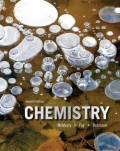
Interpretation: The balanced equation for production of copper should be determined.
Concept introduction:
- Most metals occur in nature as minerals which are generally some form of metal oxide, and the mineral must be refined to isolate the pure metal from the mineral.
- To isolate the pure metal from an ore (mineral), the ore is often concentrated and undergoes chemical treatment prior to reduction, the ore is then reduced to the free metal and the metal is then refined and purified. This process refers to metallurgy.
Answer to Problem 21.1P
Solution:
Explanation of Solution
We are asked to produce pure copper by roasting Cu2S. In this instance, roasting refers to combustion which is a reaction with O2(g). So, we know that Cu2S reacts with O2to produce pure Cu and must balance the remaining atoms:
(c)
Interpretation: The balanced equation for production of lead should be determined.
Concept introduction:
- Most metals occur in nature as minerals which are generally some form of metal oxide, and the mineral must be refined to isolate the pure metal from the mineral.
- To isolate the pure metal from an ore (mineral), the ore is often concentrated and undergoes chemical treatment prior to reduction, the ore is then reduced to the free metal and the metal is then refined and purified. This process refers to metallurgy.
Answer to Problem 21.1P
Solution:
Explanation of Solution
We are asked to produce pure lead by reducing
(d)
Interpretation: The balanced equation for production of potassium should be determined.
Concept introduction:
- Most metals occur in nature as minerals which are generally some form of metal oxide, and the mineral must be refined to isolate the pure metal from the mineral.
- To isolate the pure metal from an ore (mineral), the ore is often concentrated and undergoes chemical treatment prior to reduction, the ore is then reduced to the free metal and the metal is then refined and purified. This process refers to metallurgy.
Answer to Problem 21.1P
Solution:
Explanation of Solution
We are asked to produce pure potassium by the
Want to see more full solutions like this?
Chapter 21 Solutions
EBK CHEMISTRY
 ChemistryChemistryISBN:9781305957404Author:Steven S. Zumdahl, Susan A. Zumdahl, Donald J. DeCostePublisher:Cengage Learning
ChemistryChemistryISBN:9781305957404Author:Steven S. Zumdahl, Susan A. Zumdahl, Donald J. DeCostePublisher:Cengage Learning ChemistryChemistryISBN:9781259911156Author:Raymond Chang Dr., Jason Overby ProfessorPublisher:McGraw-Hill Education
ChemistryChemistryISBN:9781259911156Author:Raymond Chang Dr., Jason Overby ProfessorPublisher:McGraw-Hill Education Principles of Instrumental AnalysisChemistryISBN:9781305577213Author:Douglas A. Skoog, F. James Holler, Stanley R. CrouchPublisher:Cengage Learning
Principles of Instrumental AnalysisChemistryISBN:9781305577213Author:Douglas A. Skoog, F. James Holler, Stanley R. CrouchPublisher:Cengage Learning Organic ChemistryChemistryISBN:9780078021558Author:Janice Gorzynski Smith Dr.Publisher:McGraw-Hill Education
Organic ChemistryChemistryISBN:9780078021558Author:Janice Gorzynski Smith Dr.Publisher:McGraw-Hill Education Chemistry: Principles and ReactionsChemistryISBN:9781305079373Author:William L. Masterton, Cecile N. HurleyPublisher:Cengage Learning
Chemistry: Principles and ReactionsChemistryISBN:9781305079373Author:William L. Masterton, Cecile N. HurleyPublisher:Cengage Learning Elementary Principles of Chemical Processes, Bind...ChemistryISBN:9781118431221Author:Richard M. Felder, Ronald W. Rousseau, Lisa G. BullardPublisher:WILEY
Elementary Principles of Chemical Processes, Bind...ChemistryISBN:9781118431221Author:Richard M. Felder, Ronald W. Rousseau, Lisa G. BullardPublisher:WILEY





